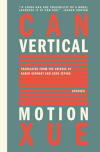Vertical Motion
Chinese writer Can Xue’s short story collection Vertical Motion captures dream/nightscapes like Steven Milhauser and the surreal like Japanese writer Haruki Murakami. The short stories do reflect real life in activities and mostly relationships, but as she says in one of her stories, “Fantasy is still the way we do things best,” which seems to mean through fantastical experiences people improve. Thus each story explores a “new realm of imagination.”
Chinese writer Can Xue’s short story collection Vertical Motion captures dream/nightscapes like Steven Milhauser and the surreal like Japanese writer Haruki Murakami. The short stories do reflect real life in activities and mostly relationships, but as she says in one of her stories, “Fantasy is still the way we do things best,” which seems to mean through fantastical experiences people improve. Thus each story explores a “new realm of imagination.”
Yet some stories seem linked to define Xue’s favorite themes. Often women, disturbed by what they see, go outside their world to discover explanations, while their men remain calmer. Strange sights or events occur during rain, though the rain may not be real. The reality of the elderly—an old uncle/father or mentor being difficult—is something the young person learns from. Sometimes the traveler gets dirty, but at the end everything is clean. These are unusual, mystifying stories, but not dark or disturbing because of their positive endings. The reader should enjoy the marvel of the imaginative images and events, and not worry about interpreting them. The warning is, as it appears in one story, “better not to look too closely” and just enjoy that “anything is possible.”
“Vertical Motion,” the first story, takes the reader where he’s never been before. It is told from the perspective of an insect moving from his earthbound life with others like him, never touching but nevertheless communicating through the dirt. This insect of especially long beak moves upward towards the surface in order to find his grandfather. Another later story, “Moonlight Dance,” seems to revisit this creature and the grandfather. With his cries, maybe a cicada?
In “The Brilliant Purple China Rose” a plant grows downward into the ground but the seeds may be just “beautiful little pebbles.” Special stones also appear in “Elena,” the only love story, in which the man travels into his beloved’s strange world, where it rains or maybe not. Rain-or-maybe-not seems to be where magic happens. In one of the best short stories, “A Village in the Big City,” a suffering young man visits his uncle who goes out in the rain from his magical building. His uncle’s apartment is on the top floor and at one point the steps disappear, leaving the building suspended in space, and at another point the steps go downward forever. Also, strange footsteps are heard. Old Uncle Leo “appeared energetic and invigorated,” and as a consequence of his visit, the nephew is cured of his pains. In “Rainscape,” a couple with an umbrella looks older on closer look, and they lead the woman narrator behind the strange, seemingly empty building opposite her own.
There is always a place where strange things happen, often a building or a garden outside a hospital, or a marshland, and people get lost. Often this happens at night, with dreams transforming ordinary phenomenon:
“Time flew last night. I overslept,” he said. It was strange: he had the same feeling. Was time different inside and outside the building? I peeped at his face. When they were dreaming, could people tell any difference in time? Since he had slept straight through, how did he know whether time had passed quickly or slowly?
“At night, people can forget anything, no matter what it is.”
“True. I’ve felt this, too. In one short night, innumerable things can occur.”
Even real life can be magical. “I’ve eaten cotton candy just twice. It was the most mystifying experience on earth. When I put that soft, transparent, fluttering white thing in my mouth, it vanished like air. It had no taste. I knew I’d seen that cotton candy was made of sugar, so why didn’t it taste sweet?” When this child begins making imaginary cotton candy, his father says, “You finally have some ambition. We feel reassured.”
The problems of the elderly seem particularly real. Even when the story is told from a cat’s perspective, an old man’s behavior creates even more confusion with a strange night visitor. Another story, actually named “Night Visitor,” delves into a similar problem. The old person’s own story in “Red Leaves” is surreal, with red leaves appearing in winter and strange events occurring in a strange building. However, when the subject is a difficult father or mentor, as in “Never at Peace,” the reality almost overtakes the fantasy. The young man can only walk away, but it “was not like leaving, but instead like sailing straight towards the dark center of his hometown. It was a place where he’d never been before.”
This extraordinary, imaginative collection of stories has that message: Mystery lives in the midst of our lives.





